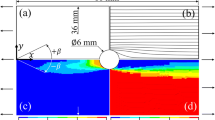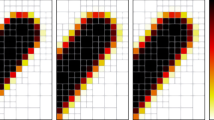Abstract
The Absolute Nodal Coordinate Formulation (ANCF) is a relatively new nonlinear finite element type that uses Hermite splines for shape functions. In this investigation, the ANCF is examined as a possible tool for use in modeling the media in flexible media transport systems, such as printers, copy machines, and roll-to-roll systems. However, it is demonstrated using an example of a thin plate-type ANCF finite element that these elements can suffer from significant membrane locking, which can be problematic for paper or paper-like media. One source of this locking is identified to be a property of all parametric curves that are composed of polynomials. The property is that for parametric polynomial curves, changes in the state of curvature of the curve cause changes in the distribution of points along the curve. This property is labeled Curve-Induced Distortion (CID) by the authors of this paper. CID can cause axial and membrane strain distortion in elements, causing them to be overly stiff. A new solution method is proposed to directly counteract CID in finite elements that use cubic Hermite curves for shape functions, specifically for modeling problems in which bending occurs primarily around one axis, such as paper in printing and media transport machinery. This method is labeled Flat-Mapped Extension Modeling (FMEM). FMEM is a mixed field method that uses a 1D Hermite polynomial kinematically linked to the 3D Hermite curve to represent the axial displacement field. FMEM significantly reduces the effect of CID in the ANCF element tested here. This investigation demonstrates using a single ANCF plate element type that the ANCF’s accuracy can be significantly improved by FMEM with only a small increase in computational cost. It is shown with this plate-element example that without correcting CID, the ANCF element tested is computationally much slower than contemporary methods like the co-rotational formulation for similar accuracy. But with FMEM, the ANCF is significantly faster than the co-rotational formulation for similar accuracy.
Similar content being viewed by others
References
Aminpour, M.A.: An assumed-stress hybrid 4-node shell element with drilling degrees of freedom. Int. J. Numer. Methods Eng. 33, 19–38 (1992)
Aminpour, M.A.: Direct formulation of a hybrid 4-node shell element with drilling degrees of freedom. Int. J. Numer. Methods Eng. 35, 997–1013 (1992)
Belytschko, T., Liu, W.K., Moran, B.: Nonlinear Finite Elements for Continua and Structures. Wiley, New York (2000)
Choi, J.: A study on the analysis of rigid and flexible body dynamics with contact. Ph.D. Dissertation, Seoul National University, Seoul (2009)
Cottrell, J.A., Hughes, T.J.R., Bazilevs, Y.: Isogeometric Analysis: Toward the Integration of CAD and FEA. Wiley, New York (2009)
Dmitrochenko, O.N., Mikkola, A.M.: A formal procedure and invariants of a transition from conventional finite elements to the absolute nodal coordinate formulation. Multibody Syst. Dyn., 22(4), 323–339 (2009)
Dmitrochenko, O.N., Pogorelov, D.Yu.: Generalization of plate finite elements for absolute nodal coordinate formulation. Multibody Syst. Dyn. 10(1), 17–43 (2003)
Dmitrochenko, O.N., Yoo, W.S., Pogorelov, D.: Helicoseir as shape of a rotating string (II): 3D theory and simulation using ANCF. Multibody Syst. Dyn. 15(2), 181–200 (2006)
Dufva, K., Shabana, A.A.: Analysis of thin plate structures using the absolute nodal coordinate formulation. Proc. Inst. Mech. Eng., Proc. Part K, J. Multi-Body Dyn. 219(4), 345–355 (2005)
Dufva, K.E., Sopanen, J.T., Mikkola, A.M.: A two-dimensional shear deformable beam element based on the absolute nodal coordinate formulation. J. Sound Vib. 280(3–5), 719–738 (2005)
Farouki, R.T., Sakkalis, T.: Rational space curves are not “unit speed”. Comput. Aided Geom. Des. 24(4), 238–240 (2007)
Farouki, R.T., Sakkalis, T.: Real rational curves are not ‘unit speed’. Comput. Aided Geom. Des. 8(2), 151–157 (1991)
Fung, Y.C.: A First Course in Continuum Mechanics. Prentice-Hall, Englewood Cliffs (1994)
Garcia-Vallejo, D., Mikkola, A.M., Escalona, J.L.: A new locking-free shear deformable finite element based on absolute nodal coordinates. Nonlinear Dyn. 50(1–2), 249–264 (2007)
Gerstmayr, J., Matikainen, M.K., Mikkola, A.M.: A geometrically exact beam element based on the absolute nodal doordinate formulation. Multibody Syst. Dyn. 20(4), 359–384 (2008)
Gerstmayr, J., Shabana, A.A.: Analysis of thin beams and cables using the absolute nodal coordinate formulation. Nonlinear Dyn. 45(1–2), 109–130 (2006)
Gerstmayr, J., Shabana, A.A.: Efficient integration of the elastic forces and thin three-dimensional beam elements in the absolute nodal coordinate formulation. In: Cuadrado, G., Orden, G. (eds.) Multibody Dynamics, ECCOMAS Thematic Conference, Madrid, Spain (2005)
Hughes, T.J.R., Cottrell, J.A., Bazilevs, Y.: Isogeometric analysis: CAD, finite elements, NURBS, exact geometry and mesh refinement. Comput. Methods Appl. Mech. Eng. 194(39–41), 4135–4195 (2005)
Malvern, L.E.: Introduction to the Mechanics of a Continuous Medium. Prentice-Hall, Englewood Cliffs (1969)
Mikkola, A.M., Matikainen, M.K.: Development of elastic forces for a large deformation plate element based on the absolute nodal coordinate formulation. J. Comput. Nonlinear Dyn. 1(2), 103–108 (2006)
Mikkola, A.M., Shabana, A.A.: A non-incremental finite element procedure for the analysis of large deformation of plates and shells in mechanical system applications. Multibody Syst. Dyn. 9(3), 283–309 (2003)
Moita, G.F., Crisfield, M.A.: A finite element formulation for 3-D continua using the co-rotational technique. Int. J. Numer. Methods Eng. 39(22), 3775–3792 (1996)
Mortenson, M.: Geometric Modeling, 3rd edn. Industrial Press Inc., New York (2006)
Pian, T.H.H.: Finite elements based on consistently assumed stresses and displacements. Finite Elem. Anal. Des. 1(2), 131–140 (1985)
Piegl, L., Tiller, W.: The NURBS Book, 2nd edn. Springer, Berlin (1997)
RecurDyn Theoretical Manual. http://www.functionbay.co.kr (2010)
Reissner, E.: On a variational theorem for finite elastic deformations. J. Math. Phys. 32, 129–135 (1953)
Schwab, A.L., Gerstmayr, J., Meijaard, J.P.: Comparison of three-dimensional flexible thin plate elements for multibody dynamic analysis: finite element formulation and absolute nodal coordinate formulation. In: Proc. ASME IDETC/CIE 2007 DETC2007-34754 (CDROM) (2007)
Schwab, A.L., Meijaard, J.P.: Comparison of three-dimensional flexible beam elements for dynamic analysis: finite element method and absolute nodal coordinate formulation. In: Proceedings of IDETC/CIE 2005 ASME International Design Engineering Technical Conference, Long Beach, CA. ASME, New York (2005). (CDROM), Paper Number DETC2005-85104
Shabana, A.A.: Computational Continuum Mechanics. Cambridge University Press, Cambridge (2008)
Shabana, A.A.: Definition of the slopes and the finite element absolute nodal coordinate formulation. Multibody Syst. Dyn. 1(3), 339–348 (1997)
Shabana, A.A.: An absolute nodal coordinate formulation for the large rotation and deformation analysis of flexible bodies. Technical Report MBS96-1-UIC, University of Illinois at Chicago, Chicago, IL (1996)
Sopanen, J.T., Mikkola, A.M.: Description of elastic forces in absolute nodal coordinate formulation. Nonlinear Dyn., 34(1–2), 53–74 (2003)
Stolarski, H., Belytschko, T.: Shear and membrane locking in curved C0 elements. Comput. Methods Appl. Mech. Eng., 41(3), 279–296 (1983)
Sugiyama, H., Suda, Y.: A curved beam element in the analysis of flexible multi-body systems using the absolute nodal coordinates. Proc. Inst. Mech. Eng., Proc. Part K, J. Multi-Body Dyn. 221(2), 219–231 (2007)
Tong, P., Pian, T.H.H.: A variational principle and the convergence of a finite-element method based on assumed stress distribution. Int. J. Solids Struct., 5(5), 463–472 (1969)
Yakoub, R.Y., Shabana, A.A.: Three-dimensional absolute nodal coordinate formulation for beam elements: theory. J. Mech. Des., 123(4), 606–613 (2001)
Yoo, W.S., Dmitrochenko, O.N., Park, S.J., Lim, O.K.: A new thin spatial beam element using the absolute nodal coordinates: application to a rotating strip. Mech. Based Des. Struct. Mach., 33(3–4), 399–422 (2005)
Zienkiewicz, O.C., Taylor, R.L.: The Finite Element Method, Vol. 1: The Basis, 5th edn. Butterworth-Heinemann, Oxford (2000)
Author information
Authors and Affiliations
Corresponding author
Rights and permissions
About this article
Cite this article
Sanborn, G.G., Choi, J. & Choi, J.H. Curve-induced distortion of polynomial space curves, flat-mapped extension modeling, and their impact on ANCF thin-plate finite elements. Multibody Syst Dyn 26, 191–211 (2011). https://doi.org/10.1007/s11044-011-9248-9
Received:
Accepted:
Published:
Issue Date:
DOI: https://doi.org/10.1007/s11044-011-9248-9




